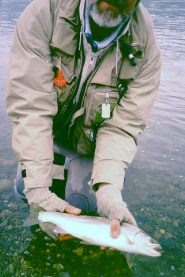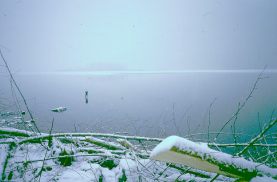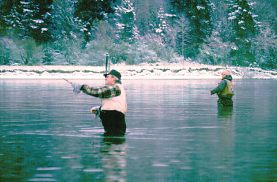 Keeping
Warm Keeping
Warm Those
Ten Damn Digits
(Keeping
the feelers in fishable form)
by
Peter Caverhill
|
|
|
Winter cutthroat - cold fish cold hands.
|
Frozen,
miserable, and weakly cursing, I was standing stock still, up to my navel
in the wind and rain swept winter water of the slough. My fly rod was
awkwardly rammed down into my chest waders and my icy, heat seeking paws
were clamped tightly under my cooling armpits. I'd been in this miserable
position for at least ten minutes, trying desperately to get some feeling
back into my casting instruments so that I could resume fishing. I knew
that if warmth and feeling returned, it would be short lived. Perhaps
I'd get another ten casts off before I'd have to resume my former unhappy
position.
Cold numb
hands are the enemy of the fly fisher who needs considerable finger dexterity
and 'feel' to be able to cast and fish the fly effectively. And, fishing
is supposed to be fun , not some damn survival contest with the elements.
Winter may be the toughest time for hands and fingers, but in any season,
conditions can arise that render these extremities sore and nearly useless.
Some anglers (who must be descended from North Sea fisherman stock!) can
fish bare- handed and happy in the worst conditions. For the rest of us,
it's either quit for the day or try to convince our brain's temperature
center that it's having a good time.
Keeping
hands and their fingers warm under adverse conditions is an on-going science.
Since I'm one of the genetically inferior, I'm constantly looking for
methods superior to the old arm pit trick. My chronically cold, numb fingers
have led me on a long quest for the perfect solution for warmth and dexterity.
Of course, perfection doesn't exist (the only true answer is to stay home
and watch fishing videos). However, I've learned a few things to try that
should go a long way toward making those cooler fishing excursions more
bearable.

The Body
Core
It's a matter
of priorities for the body's control center. If the main core (chest,
trunk, thighs and head) isn't toasty, the poor old extremities won't have
a chance. So the first step is to try to keep the core warm with layered,
water-proof and wind proof gear that can be removed, opened or closed
to regulate temperature as the environment of the moment dictates.
Hands,
Fingers and Fly Casting 'Feel'
Hands and
fingers need to stay warm, but must maintain enough dexterity or 'feel'
to be able to accomplish the tricky aspects of fly casting. Despite the
weather, there are double hauls, line releases and retrieves, and reeling
in of large, active fish that must be done. Hands equipped with big puffy
mitts may be hot as chili, but they won't do a darn thing for the rod
and line- handling dexterity. It's guaranteed frustration! However, with
a little perseverance and practice, one can become skilled at performing
the necessary rod and line activities with glove -encumbered hands. So,
the two needs - warmth and 'feel'- are always in competition. A balance
must be struck.


Glove Systems
for Hand/Finger Warmth
|
|
|
Fraser River winter - cutthroat search.
|
If the core
is warm but the hands are still in cold storage and stiff, it's on to
stage two - the search for a glove system that will do the job for warmth
and dexterity. Over the years I've tried just about every kind of glove/mitt,
short of the ones with built-in battery operated heaters. Many of these
gloves are made specifically for fishing. Finding the combo or system
that works best for you will take some experimentation. Here's my opinion
on what's available out there ( and remember on a scale of 1 to 10 - where
1 is frozen and 10 is hot - I'm near one. You'll probably be somewhere
above this on the scale).
Fingerless Gloves ( wool, synthetic, rubber, fleece or some combination)
- in these, the pinky ends are exposed to the world. Their goal is to
provide a measure of warmth while maintaining the all important 'feel'.
There is also a hybrid of this glove that incorporates a permanently attached
mitt portion that can be pulled over the fingers ( extra warmth traded
for decreased dexterity).
These gloves
aren't bad when the conditions are less extreme and they do provide good
dexterity. However, they frequently wet through, and that's when the cold
really comes. When wet, my stiff fingers have difficulty peeling them
off them in order to seek out some outside heat source.
Neoprene Gloves ( thin diver-suit foam rubber ) Newer more expensive
ones have a permanently bonded very light "fleece-like" lining. Some are
intact gloves, while others have finger slits so that key fingers ( like
the thumb and forefinger) can be exposed. Intact gloves are mostly waterproof
while the slitted ones are not. The best ones are designed with a "relaxed"
or curved finger profile.
These gloves
are certainly worth looking into. They are fair for warmth, and good for
dexterity. However, they don't "breathe" the way fabric gloves do, so
there will be condensation that creates clammy, cold, interior conditions.
I prefer the complete, intact gloves that are waterproof. These can be
immersed in water without leakage ( good for releasing fish). Avoid overly
tight neoprenes. They will cool the fingers faster and be tiring, as the
fingers constantly have to flex against the springy rubber. A downside
is the difficulty of getting these gloves on and off when they are damp
inside ( another reason to avoid the tight ones).
Waterproof "Ski" Gloves ( can be the standard 5-fingered version
or the rarer 3- fingered "semi-mitt".Good ones have the "relaxed" fingers
). I really like these gloves, because they are good for us "cool handers".
They potentially provide more warmth because they have more insulation.It's
important to find ones that aren't bulky on the palm side of the hand
so they don't lose dexterity. Look for models that have a wide, open cuff.
Avoid the close-fitting knitted cuff styles because these will drive you
crazy trying to get them on and off under cold and wet, "sticky" conditions.
|
|
|
Late November - after coho salmon.
|
Water-proof
is really important. True water-proofing in this type of glove can be
very hard to find, as it requires a breathable, water- proof liner ( often
Gore-tex ) that is not sewn through when the glove is made. Many gloves
will claim to be water-proof, yet leak like sieves because they have a
million sewn-through seams (the fabric may be water-proof, but the seams
are not). Ask lots of questions, and buy these gloves when they are deeply
discounted since they can be expensive.
The 3-fingered
style has the warmth advantage of keeping groups of fingers together,
while the split palm still provides for reasonable dexterity.
Neoprene
Waders/Integrated Handwarmer Pockets
Many brands
and models of neoprene chest waders are made with a special handwarmer
"pocket" on the front, at the level of the angler's lower chest or gut.
This pocket lies flat against the body and therefore picks up body warmth.
This really helps to warm chilled hands. This is a very useful wader option,
and contributes to the pinkie protection plan.
Outside
Heat Sources
There is
no 100%, "warm -all -the -time" glove system. For really extreme conditions,
or very sensitive fingers, outside heat sources are the best. These can
very quickly tune-up the digits for a few more casts. I've tried all manner
of easy to carry heat generating devices. For years I carefully went through
the tedious rituals associated with lighter fluid and charcoal stick hand
warmers. They worked well enough, but were difficult to light in the field,
and were better lit indoors, in anticipation of the conditions. They also
stank like a refinery or an old fire.
Hand warmer
evolution produced a non-disposable, chemical reaction warmer that I tried
and very quickly rejected. These were expensive to purchase, heavy and
bulky, short-livedfor heating and too easily activated by accident. They
also required a fiddly process of boiling in hot water to return the dead
warmer back to an active state.
I've since
discovered the magic of disposable hand warmers. They come in a flat sealed
plastic packet and are sold in most outdoor stores in winter. They are
available in two sizes: a larger "pocket" warmer size or a smaller size
that will fit inside a glove ( sold 2/pack). The beauty of these is that
they can be carried in a fishing vest or bag, and only need be activated
if the conditions warrant. They are easily started by ripping open the
packet, removing the inside pouch, and then massaging it's guts. When
exposed to air, the simple vermiculite, salt, and iron filing ingredients
engage in a heat producing odorless reaction that will keep a pocket warm
for up to eight hours.
The best
environment for keeping these warmers operating at peak heat-producing
efficiency is a loose,dry pocket. Down or fleece vests or jackets usually
have front or side pockets that are ideal. A warmer in each pocket of
the garment ( which is worn inside the chest waders ) is very easily reached
by cold hands. These warmers do not like to get damp, so wet glove removal
prior to gripping the warmer is a must.
Putting
it all Together
The system
I find best is a combination of the previous items discussed. The disposable
warmers are the central ingredient, and without these I'd be lost. I use
the warmers for a heat source, combined with any of the glove types. I'll
often use a different glove type on the rod hand ( ie. bulkier and warmer,
since less dexterity is required) and on the line hand ( ie fingerless
or neoprene, with full or split fingers, since more dexterity is needed).
The line hand will likely cool faster, requiring more dips into the hand
warmer pocket.
When I remove
gloves to access the heat sources I'll stick the gloves in a warmer place
(down my waders, or in the wader hand warmer pocket). This keeps the gloves
pre-warmed, avoiding a frigid environment for the semi-warmed hands.
So - There
should no longer be any excuses for avoiding casting and fishing because
the hands are frigid whimps, unless you really do prefer to video fish
in the warmth of a home fire with some fine tasting beverage that possesses
anti-freeze properties!
Peter's
Arcticles...
|



 Keeping
Warm
Keeping
Warm 

